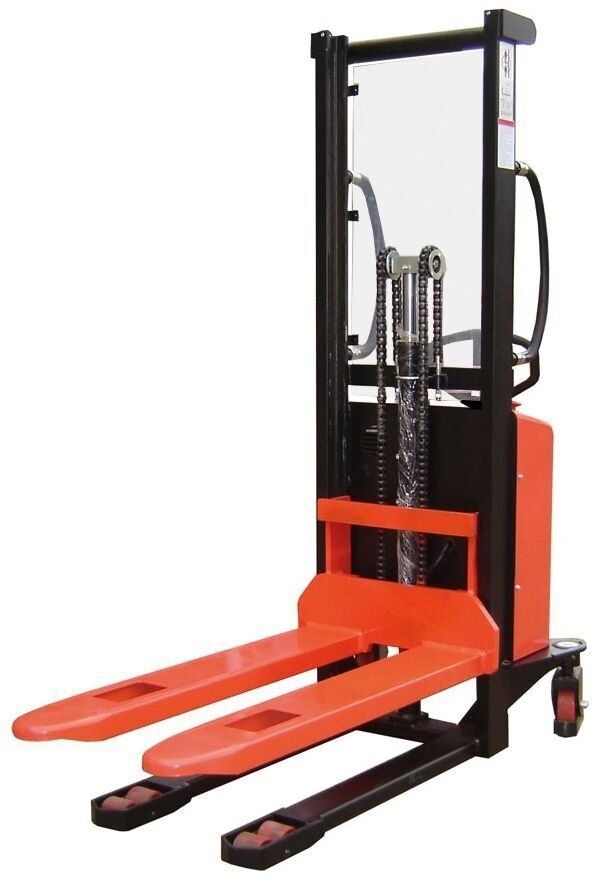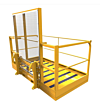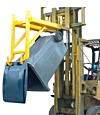
Understanding Operator Certification Requirements for Powered Industrial Stackers
One of the most common questions from warehouse and facility managers considering powered material handling equipment is straightforward yet surprisingly complex: "Do you need a license to operate a powered stacker?" This question reflects legitimate concerns about regulatory compliance, safety standards, liability exposure, and training requirements. Understanding the precise legal requirements for powered stacker operation is essential for any organization using or planning to use this equipment.
While the answer involves some nuance based on equipment type, jurisdiction, and specific workplace factors, this comprehensive guide clarifies the regulatory requirements and best practices surrounding powered stacker operation authorization.
The Regulatory Framework: OSHA Requirements
The primary regulatory guidance in the United States comes from the Occupational Safety and Health Administration (OSHA):
OSHA's Stance on Powered Industrial Trucks
OSHA regulation 29 CFR 1910.178 addresses operator requirements:
- Scope of coverage: Applies to "powered industrial trucks," a category including forklifts and certain types of powered stackers
- Training mandate: Requires comprehensive operator training before operation
- Certification requirement: Specifies that employers must certify all training and evaluation
- Renewal provisions: Mandates re-evaluation of operators every three years
- Specific limitations: Restricts operation to trained and evaluated personnel
- Age restrictions: Prohibits operation by anyone under 18 years of age
- Documentation requirements: Necessitates records of all training and evaluation
This regulation forms the foundation for powered stacker operator requirements.
Classification Distinctions
OSHA distinguishes between different equipment classifications:
- Class I: Electric motor trucks with cushion or pneumatic tires
- Class II: Electric motor narrow aisle trucks (including many stackers)
- Class III: Electric motor hand trucks or hand/rider trucks (including walkie stackers)
- Class IV-VII: Various internal combustion engine trucks
These classifications impact specific training requirements and operational restrictions.
Powered Stackers vs. Pedestrian-Controlled Equipment
An important regulatory distinction exists:
- Rider-operated equipment: Generally subject to full forklift-equivalent requirements
- Pedestrian-controlled equipment: May have different requirements depending on specific features
- Walk-behind powered stackers: Often classified under Class III with specific provisions
- Platform-rider stackers: Typically treated similarly to stand-up forklifts
- Determination factors: Riding platform, operational controls, and lifting capacity
Understanding your specific equipment classification is critical for determining applicable requirements.
What Constitutes a "License" for Stacker Operation
The term "license" deserves clarification in this context:
No Government-Issued License Exists
Unlike driving a car, there is no government licensing process:
- No state-issued licenses: No DMV equivalent for industrial equipment
- No federal licensing program: OSHA requires training but doesn't issue licenses
- No national registry: No central database of approved operators
- No standardized testing: No universal examination for operators
- No portable credential: Authorization is employer-specific, not transferable between companies
- No third-party approval: Employers, not external agencies, authorize operators
- No universal ID card: Though training cards may be issued, they're not official licenses
This distinction is important for understanding compliance requirements.
Actual Requirement: Employer Certification
What OSHA actually requires is employer-provided authorization:
- Training verification: Documentation of completed required training
- Competency evaluation: Assessment of operator skill and knowledge
- Written certification: Formal record of training and evaluation
- Employer authorization: Specific permission to operate equipment
- Equipment-specific approval: Authorization for particular machines or classes
- Worksite-specific elements: Training relevant to the actual operating environment
- Ongoing compliance verification: Periodic reassessment and documentation
This employer-based certification system places responsibility on the organization rather than an external licensing authority.
Training and Certification Requirements
Proper preparation of operators involves several key components:
Required Training Elements
OSHA-compliant training must include:
- Formal instruction: Classroom-style education on principles and regulations
- Practical training: Hands-on operation under supervision
- Workplace-specific orientation: Training on site-specific hazards and conditions
- Equipment-specific instruction: Training on the particular stacker models being used
- Performance evaluation: Observed assessment of operating skills
- Documentation: Written records of all training components
- Certification: Formal employer verification of completion
- Periodic refresher training: Updated instruction at required intervals
This comprehensive approach ensures operators understand both theoretical and practical aspects of safe operation.
Who Can Provide Training
Training may come from several sources:
- In-house safety personnel: Qualified company employees can conduct training
- Equipment manufacturers: Many OEMs offer certified training programs
- Third-party trainers: Specialized safety training companies
- Industry associations: Some trade groups provide approved training
- Online/classroom components: Theoretical portions may be delivered electronically
- Hands-on requirements: Practical training must be conducted in person
- Trainer qualifications: Trainers must have knowledge and experience with the equipment
The key requirement is that trainers must be competent and knowledgeable about the equipment and regulations.
Documentation and Record-Keeping
Proper documentation is essential for compliance:
- Training content records: Topics covered and materials used
- Attendance verification: Proof of participation in all required sessions
- Evaluation documentation: Records of performance assessment
- Certification records: Formal documentation of successful completion
- Refresher training logs: Tracking of periodic retraining
- Equipment-specific notations: Documentation of which machines operators are authorized to use
- Retention requirements: Records must be maintained while the operator is employed
These records are critical evidence of compliance in case of inspection or incident.
Specific Requirements for Different Stacker Types
Regulatory requirements can vary by equipment configuration:
Walkie Stackers (Walk-Behind)
These pedestrian-controlled units have specific considerations:
- OSHA classification: Typically Class III electric motor hand trucks
- Training focus: Emphasizes pedestrian operation and control
- Certification requirements: Full OSHA training and certification still required
- Common misconception: Often incorrectly assumed to have reduced requirements
- Key distinction: Operator walks rather than rides, but powered operation still triggers training requirements
- Site-specific elements: Particular attention to pedestrian traffic areas
- Practical evaluation: Must include actual operation with typical loads
Though simpler than sit-down equipment, walkie stackers still require complete operator certification.
Rider Stackers (Stand-Up)
Units with operator platforms have requirements similar to forklifts:
- OSHA classification: Often Class II narrow aisle trucks
- Training scope: Comprehensive program equivalent to forklift training
- Fall protection emphasis: Special attention to platform safety
- Stability considerations: Focus on balance and load management while riding
- Visibility training: Techniques for maintaining sightlines while standing
- Clearance awareness: Special attention to overhead obstacles
- Emergency procedures: Platform-specific response training
These units generally trigger the full range of powered industrial truck requirements.
Specialized Stackers
Certain configurations may have additional requirements:
- Order pickers: Additional fall protection and elevated work training
- Narrow aisle equipment: Special training for confined space operation
- High-reach models: Additional emphasis on overhead obstacle awareness
- Counterbalance stackers: Specific stability and balance training
- Multi-function equipment: Training on all operational modes
- Attachment-equipped units: Specific training for each attachment type
- Semi-automated systems: Interface and override training
Specialized equipment may require supplemental training beyond basic certification.
Beyond OSHA: Additional Considerations
Several factors beyond basic OSHA compliance affect authorization requirements:
Insurance Requirements
Insurance providers often impose additional standards:
- Coverage prerequisites: Many policies require specific training programs
- Documentation demands: Insurers may request training records during audits
- Preferred providers: Some insurers recognize specific training programs
- Claim impact: Incidents involving untrained operators may affect claims
- Premium influences: Training programs may affect insurance costs
- Self-insured programs: May have their own specific requirements
- Liability protection: Proper training significantly affects liability exposure
Insurance requirements may exceed OSHA's minimum standards in some cases.
International Variations
Requirements differ in other countries:
- European regulations: Often more formalized training and certification
- UK requirements: Specific "competence" certifications under PUWER regulations
- Canadian standards: Provincial variations on operator qualification
- Australian framework: Nationally recognized competency standards
- Global corporations: Often adopt most stringent requirements across operations
- Cross-border operations: May need to satisfy multiple regulatory frameworks
- International standards: ISO safety standards may apply to multinational operations
Organizations operating internationally must consider varied regulatory approaches.
Industry-Specific Standards
Some sectors impose additional requirements:
- Pharmaceutical manufacturing: May require additional GMP-related training
- Food production: Often includes food safety aspects in operator training
- Hazardous materials handling: Requires supplemental HAZMAT training
- Aerospace: May have industry-specific certification requirements
- Automotive manufacturing: Often implements enhanced training protocols
- Défense contractors: May have security-related authorization elements
- Public sector operations: Sometimes involves government-specific requirements
Industry standards can significantly extend basic regulatory requirements.
Implementation Best Practices
Effective programs typically exceed minimum requirements:
Comprehensive Training Programs
Develop robust preparation beyond basic compliance:
- Equipment-specific modules: Tailored to each stacker model
- Facility-specific elements: Addressing unique workplace layouts and hazards
- Progressive skill development: Building competence in structured stages
- Hands-on emphasis: Substantial practical operation under supervision
- Scenario-based training: Practicing responses to various situations
- Knowledge verification: Testing understanding of principles and procedures
- Documented evaluation criteria: Clear standards for performance assessment
- Remedial options: Additional training for operators needing improvement
This thorough approach creates genuinely qualified operators rather than merely certified ones.
Authorization Management Systems
Implement structured authorization tracking:
- Centralized records: Single-source documentation of all operator authorizations
- Equipment-specific designations: Clear recording of which operators can use which machines
- Expiration tracking: Automated monitoring of certification renewal dates
- Visual identification: Badges or other systems identifying authorized operators
- Supervisor access: Ensuring management can verify current authorizations
- Equipment access control: Considering key cards or codes for authorized users only
- Digital documentation: Electronic systems for tracking and verification
These systems ensure only properly certified personnel operate equipment.
Continuous Improvement Approach
Extend beyond minimal periodic retraining:
- Refresher scheduling: Regular updates before required three-year intervals
- Incident-triggered review: Additional training following accidents or near-misses
- Observational evaluation: Ongoing assessment of operator habits and practices
- New feature training: Updates when equipment is modified or enhanced
- Safety meeting integration: Regular discussion of stacker operation best practices
- Operator feedback incorporation: Using input from operators to improve training
- Performance incentives: Recognizing and rewarding exceptional operating practices
This ongoing focus maintains and enhances operator skills between formal recertification.
Making the Right Decision for Your Operation
Determining appropriate requirements for your specific situation:
Risk-Based Approach
Consider these factors in developing your program:
- Equipment types: Specific stacker models and configurations in use
- Operating environment: Facility layout, traffic patterns, and special hazards
- Material handled: Nature, value, and potential dangers of loads
- Operator experience levels: Prior training and equipment familiarity
- Operational intensity: Frequency and duration of equipment use
- Regulatory jurisdiction: Local, state, and federal requirements
- Industry standards: Sector-specific expectations and practices
- Insurance guidance: Provider recommendations and requirements
These considerations help develop appropriately scaled training requirements.
Balancing Compliance and Practicality
Find the right operational approach:
- Minimum requirements: Understanding the absolute baseline for compliance
- Best practice targets: Identifying ideal training and authorization processes
- Resource allocation: Matching program scope to available training resources
- Implementation timeline: Phasing in comprehensive programs as practical
- Prioritization strategy: Addressing highest-risk operations first
- Documentation focus: Ensuring proper records regardless of program scope
- Continuous improvement plan: Setting a trajectory toward best practices
This balanced approach ensures compliance while working toward optimal safety practices.
Expert Support for Your Stacker Operation Requirements
Navigating the question of whether you "do you need a license to operate a powered stacker" involves understanding various regulatory requirements, training best practices, and documentation standards. At Hall-Fast, we're committed to helping our customers not only find the right equipment but also implement appropriate safety and compliance programs.
Our team can provide guidance on training resources, documentation systems, and best practices for powered stacker operation. Whether you're implementing a new program or enhancing existing practices, we can help you identify the right approach for your specific operational needs.
Explore our full range of material handling solutions at Hall-Fast Industrial and Commercial Equipment or contact our team directly at sales@hall-fast.com for personalized assistance with both equipment selection and safe operation guidance.
By implementing appropriate training, certification, and authorization programs, you'll ensure both regulatory compliance and the safe, efficient operation of your powered stacking equipment.












